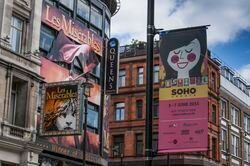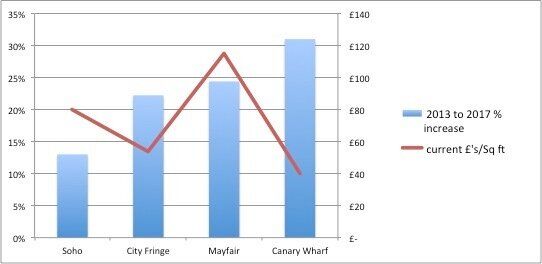With 46,000 creative workers producing a combined turnover of £7.5billion some question the need for any intervention in the development of Soho's successful creative cluster. As entrepreneur and investor Tom Teichman said when asked why he set up his disruptive incubator, The Garage, in Soho -
"In Soho we have a great advantage over most of the cities in the world and most of the world's creative hubs, because here we have the greatest concentration of creative talent on the planet."

The biggest challenge Soho faces is the growing cost of doing business, a result of its success. A challenge for Soho now is very shortly one for London, very closely followed by Birmingham and other UK cities, as the lack of office space forces prices sky high, and housing prices make inner city living only possible for the well off.
A high price for just doing business in our cities threatens to shift creative companies and people to the periphery. Some argue this is just the cycle of geographic shifts in business clusters. However, this shows a catastrophic misunderstanding of how clusters work, how they grow and the incredible economic value they have.
London is at a crucial point in decisions on where it wants its creative industries to be. Soho is a brilliant example of a world class cluster, and how it solves the challenges it now faces will form a roadmap for other cities.
With changes in how business rates are spent, local authorities will shortly have the opportunity to form cluster strategies around their profitable trade groupings. There has never been a better time nor a stronger need, for the public and private sectors to cooperate around cluster support and growth in our cities. This must be driven by the private sector working together to put appropriate cooperative working in place around recruitment, training, ideas development and place marketing. The public sector needs to support this not devise it.
Soho now.

The Soho cluster has been growing for 350 years since the Huguenots first set up here. It now has the biggest concentration of Oscars outside Hollywood and some of the world's most creative brands and service companies are based here.
Since the mid 1800's theatre has been a dominant art form in Soho, bringing with it the musicians, actors and crafts people that formed the next leap in Soho's growth as a creative cluster. West End Theatre now sells about £15million in tickets every year.
It was the film and television industry that lit the fuse for today's Soho. John Logie Baird made the first demonstration of television here way back in 1926. Some argue, that film industry success was on the back of the porn film industry in the 1950s. Never-the-less, Soho quickly built an integrated cluster of film, development, production, post production and distribution businesses which took off in the 1960s, partly on the back of the actors, agents, lawyers and musicians already active in theatre. Out of this, blossomed the advertising, design, special visual effects, sound design and post production expertise that have driven Soho's growth since then.
In the same way, a small cluster of music publishers gave rise to 'Tin pan alley' or Denmark Street, where, for the last fifty years, every business has been music related.
The flames were fanned by new UK Broadcaster, Channel 4, setting up in the Cluster in nearby Charlotte Street in the early 1980s. By the mid 1980s Channel 4 was spending £35million on independently produced programmes, many of them produced and post produced in Soho.
Movie franchises like Star Wars and Harry Potter and now James Bond are major contributors to Soho's growth and innovative success. Sue Lyster, head of studio operations at Soho's Industrial Light & Magic says:
"Harry Potter and the VFX houses made London a European Hub".
ILM's move to London comes on the back of a 15 year development of Soho's visual effects industry, culminating in Oscars for Framestore's Gravity and Double Negative's Interstellar.
For those interested in the geeky granularity of cluster mapping it's worth noting that the name of prolific film producer David Heyman can be linked with many of the productions and companies listed as part of Soho's success story. His own company Heyday Films is part of the Cluster in Denmark Street.
Soho has always been a real mix of the high life and low life, the artists, craftspeople, entrepreneurs, drunks and sex workers. Many of its more famous characters would be happy to be all of these. This gives the area an edgy caché much loved by its residents and workers alike.
Soho has now become the most creative square mile in the world.
Cluster advantages.
In fact clusters are delineated not by geography but trade. The Soho Cluster stretches up into Fitzrovia and the BBC at Langham Place, across into Mayfair on one side and across Denmark Street and Tottenham Court Road into the fringes of Covent Garden on the other.
On the back of its strong history in tailoring and fashion innovation, Soho was chosen as the new base for London Fashion Week in 2015. Caroline Rush, Chief Executive of the British Fashion Council said of the move:
"The long term growth of the UK's designer fashion market is reflected geographically in this move that will see London Fashion Week designers showcasing collections in one of London's most vibrant, diverse and creative hubs."
Soho is also jam-packed full of innovators and early adopters, being part of a global creative economy, Soho companies must keep ahead of competitors.
With so many large and small companies gathered in just a few square miles across the supply chain of so many different creative sectors there are a number of distinct advantages:
- Transportation - the best is just a walk away.
- Interconnectivity - many companies and people know each other.
- Proximity - of knowledge, skillful people, technology
- Close competition - driving and motivating. Peer pressure and pride spur creatives to outdo one another
- Close cooperation - a mutual dependency means success for one is success for all.
- Talent pool - constantly growing and refreshing.
- Integration and consolidation - small companies grow big and are bought by bigger companies, and new small companies are started.
- Porosity - knowledge and innovation flows freely between companies who know and trust each other.
- Quality - the best companies with the best people have the best ideas.
"Extensive market, technical, and competitive information accumulates within a cluster, and members have preferred access to it. In addition, personal relationships and community ties foster trust and facilitate the flow of information. These conditions make information more transferable. A host of linkages among cluster members results in a whole greater than the sum of its parts. Because members of the cluster are mutually dependent, good performance by one can boost the success of the others. A cluster allows each member to benefit as if it had greater scale or as if it had joined with others formally--without requiring it to sacrifice its flexibility."
Michael Porter - Clusters And The New Economics Of Competition.
The cost of doing business
It's clear that Soho has some extraordinary cluster advantages which it has exploited to the full up until now.
However, as the cost of doing business increases so the desire and ability of companies to cooperate and innovate decreases. Primary costs of doing business for Soho cluster companies are staff and office costs.
The high cost of entry to Soho both in terms of the extremely high level of incumbent competition and financial cost of office rents and staffing, makes it difficult to start new young companies in the area.
Soho has a tradition of diversity and prides itself on accepting outsiders. Phil Thompson, Head of Investment and Development at Soho Estates, says
"Soho is home to the people who don't feel at home anywhere else."
There has to be an element of churn in companies and people to keep the Cluster alive. It's vital to have new companies coming in to keep the level of innovation and quality of the creative pool high. As Michael Porter says -
"At the intersection of clusters, insights and skills from various fields merge, sparking new businesses."
Office.
UK Government policy that allows the easy conversion of office space to residential addresses only one side of the problem. As UK competitiveness and productivity grows the demand for office space grows alongside it. A review of available office space across the UK in the Estates Gazette suggests that our major cities will run out of available office space in the next four years and London and Birmingham have just two years left, before the supply of office space runs out.
Michael Davis from Global estate agents JLL was recently quoted in Estates Gazette -
"I have waxed lyrical about the war for talent and why people like Amazon move back into town, but to deliver space in that time we need land and larger schemes. You are looking at Silvertown, Stratford East, Surrey Quays, Vauxhall"
Central London does not have a lot more space to build except up. So unless some significant planning changes are made by government to allow buildings to add extra floors of offices its unlikely that supply will alter.
Areas like Mayfair and Soho, already at capacity, are some of the most expensive in London. However, capacity is in increasingly short supply across central London. Forward projections of office rental costs suggest that Soho will slow down whilst other areas continue to rise. Price differentials in office rentals across London will eventually narrow and everywhere will be expensive.

The figures for this chart are derived from combining multiple different sources including the Estates Gazette Informa panel figures. Though Soho remains expensive it's clear that other areas of London are catching up rapidly.
What is a problem for Soho now will be a problem for the whole of London soon. High rent and rates make achieving a profit that much harder, so there have to be other benefits of being here.
This makes the cluster benefits even more essential, and they must be developed and protected.
Staff.
If you are creative then Soho is one of the best places to work in the world. Staff want to be working on the best projects with the best people. Soho is a place where ideas are developed fast and to a very high level. Companies are highly competitive and cooperative, two aspects that act together to increase the quality of work produced.
The speed of change is fast and jobs that exist today may be replaced tomorrow with jobs that don't yet exist.
It's important that Soho companies fully utilize their position in one of the worlds best creative clusters to attract and retain staff. They need to cooperate around solving the challenges of future recruitment. Public sector support can be aligned to help.
The public sector.
The cluster advantages of Soho are immense and currently outweigh the disadvantages of doing creative business in central London. However, as a brand Soho is underpromoted with large public sector marketing campaigns for other less effective areas of London taking precedence. Geographic regeneration is seen as more worthy of support than commercial profitability and a proper industrial strategy.
All the academic research on clusters suggests they take many decades to build and an effective strategy has to focus on existing successful clusters instead of trying to build new ones from scratch. The public sector is well advised to align itself with the commercial private sector when examining cluster interventions and strategies.
The Soho cluster doesn't easily comply with standard industrial classification codes. These tracking systems also fail to capture some of the more important relationships and interactions that are crucial to business. Current government tracking would place David Heyman's Heyday Films as a SME operating in Motion Picture, Video and TV programme production activities, rather than a creative entrepreneur and catalyst for most the UK's success in special visual effects worth many billions of pounds.
There needs to be a proper joining up of the public and private to best benefit Soho and its companies. In the UK local authorities are about to have more control over where and how business rates are recycled. Westminster City Council is already a strong supporter of the Soho Creative Cluster and a powerful ally in its development. This cooperation, support and understanding needs to be heightened and finessed through a strong and ongoing research base and aligning of business support activity toward those companies and clusters most likely to use it to increase profitability.
Conclusion
Soho is one of the best developed creative clusters in the world, having grown up over 350 years and being made up of many different creative sectors. The density of workers from multiple sectors give it huge advantages with the best possible opportunity to maximize productivity through cooperation.
As Michael Porter points out -
"the enduring competitive advantages in a global economy lie increasingly in local things--knowledge, relationships, motivation--that distant rivals cannot match"
The biggest threat to the Soho Creative Cluster is that the costs of doing business and the 'drag' effect on profitability could eventually undermine all the benefits of being in central London.
The problems Soho faces now will be faced across London in the next few years. The public sector has to work closely with the cluster ensuring everything is being done to fully exploit the cluster advantages and to prioritise profitability of commercial companies across all strategic areas.
It's essential that companies within the cluster work together to ensure they are maximising all the benefits the cluster has to offer. Cooperation is key to the ongoing success of the cluster, and particular attention needs to be paid to cooperation in recruiting into the cluster and promoting the numerous benefits to potential staff of working in such a world class area.
Promoting Soho itself has to be a priority, as the Soho brand is a crucial tool in recruitment. This can only be done through cooperation.
The public sector should align itself firmly with the private sector to solve the growing issue of the price of entry to small start up companies in Soho. Small companies should be at the heart of Soho rubbing shoulders daily with the bigger, commercially successful global players.
Soho remains a world class cluster with huge advantages as a result. We now have to work together to ensure the next 350 years are as successful as the last.
